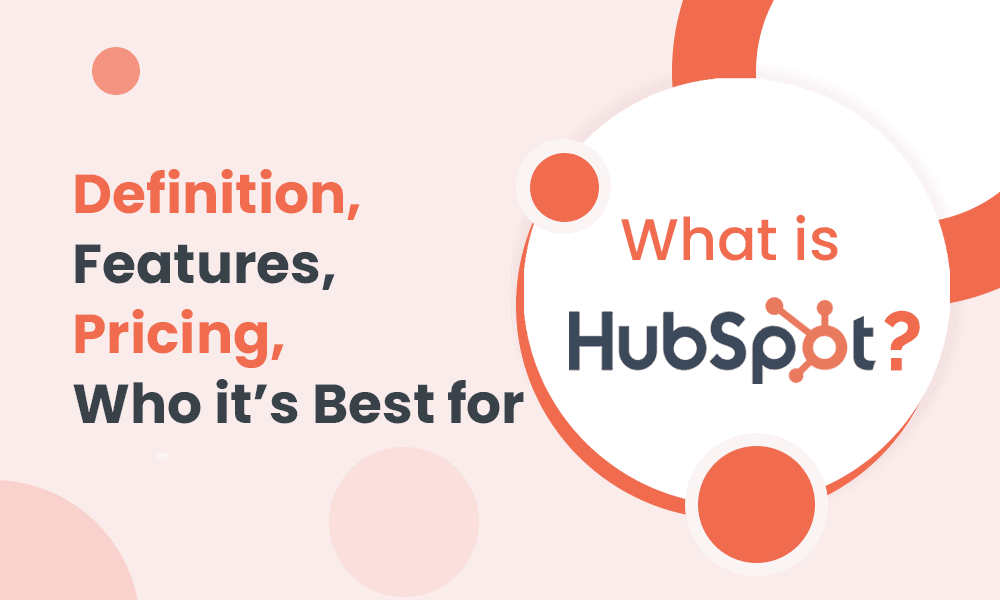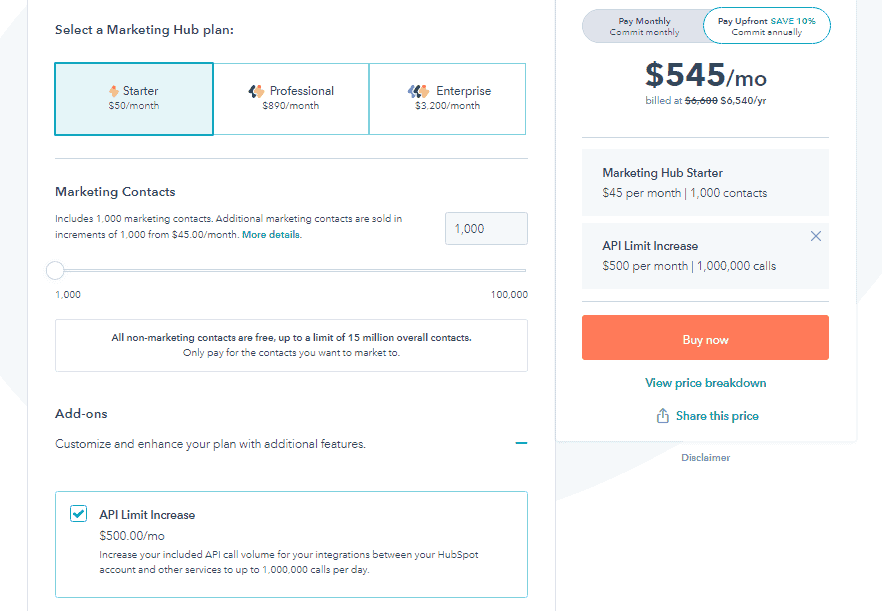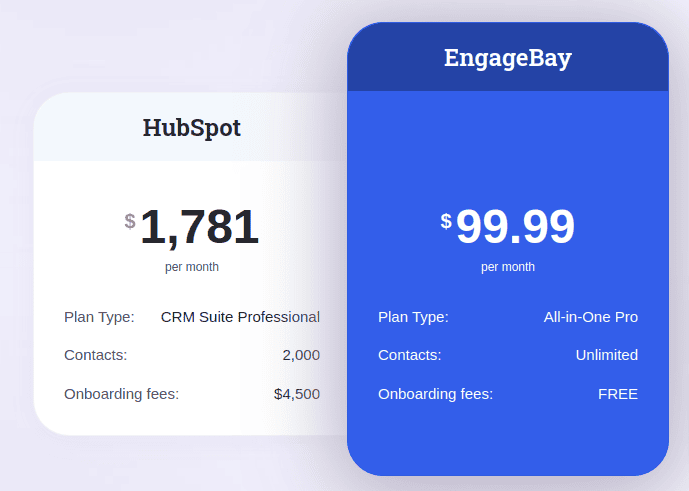For nearly every marketer or business owner, inbound marketing and all-in-one CRM bring one name to mind.
HubSpot.
HubSpot is one of the popular all-in-one CRMs. And like most well-known unified CRMs, the HubSpot CRM platform provides a suite of sales, customer service, content management, and operations tools — and it even supports LinkedIn HubSpot integration to help you sync your LinkedIn data straight into your CRM.
Having these tools in one place is a win because you get to skip the trouble of juggling from one software to another. The best part is that, like many CRM software, HubSpot has free plans you can explore before you opt for a paid plan.
For some businesses, the HubSpot CRM platform is a good starting point to streamline marketing and sales-related processes. But is HubSpot really the best CRM software for you as an SMB owner (even with its free plan)?
Not quite.
Several factors make HubSpot CRM a less ideal choice for small and mid-size businesses. These factors range from limited functionality to hefty pricing plans and more which we will cover in this guide.
Here is exactly what you’ll be learning today about the HubSpot CRM:
- What is HubSpot?
- Is HubSpot CRM Free to Use?
- Why is HubSpot expensive?
- Is HubSpot Worth the Money For Small Businesses?
- What is a Great HubSpot Alternative for SMBs?
But before we dive in, here’s a quick comparison of HubSpot’s with two other popular CRMs:
Even though HubSpot offers a robust CRM, here’s how it compares with top alternatives like EngageBay and Zoho CRM:
-
Cost to get started: HubSpot’s Starter Customer Platform sits at $20–$50 / mo but its contact‑based pricing climbs fast; EngageBay’s Basic Plan is $12.74 / user / mo (plus a free‑forever tier) and Zoho’s Standard plan is $14 / user / mo, so both stay friendlier to small budgets.
-
Automation unlock point: Full workflow automation kicks in for HubSpot only at the $100 / seat Professional tier; EngageBay introduces multi‑channel automations in its Growth Plan ($55.24 / user / mo) (and basic triggers even in Free), while Zoho adds advanced “Blueprint” automation at $23 / user / mo (Professional).
-
Hidden fees & branding: HubSpot layers on mandatory onboarding ($1.5K – $7K) and keeps its logo on free assets; EngageBay and Zoho drop the branding once you’re on a paid plan and charge no onboarding fees.
-
Free‑tier seat limits: HubSpot Free caps you at 2 users; Zoho Free offers 3 users; EngageBay Free lets 15 users collaborate—big advantage for lean teams.
-
Best‑fit snapshot:
-
HubSpot → Enterprise‑grade inbound stack if budget isn’t a blocker.
-
EngageBay → All‑in‑one sales‑plus‑marketing suite at startup‑friendly pricing (Basic $12.74, Growth $55.24, Pro $101.99).
-
Zoho CRM → Affordable per‑user model with deep customization for growing SMBs.
-
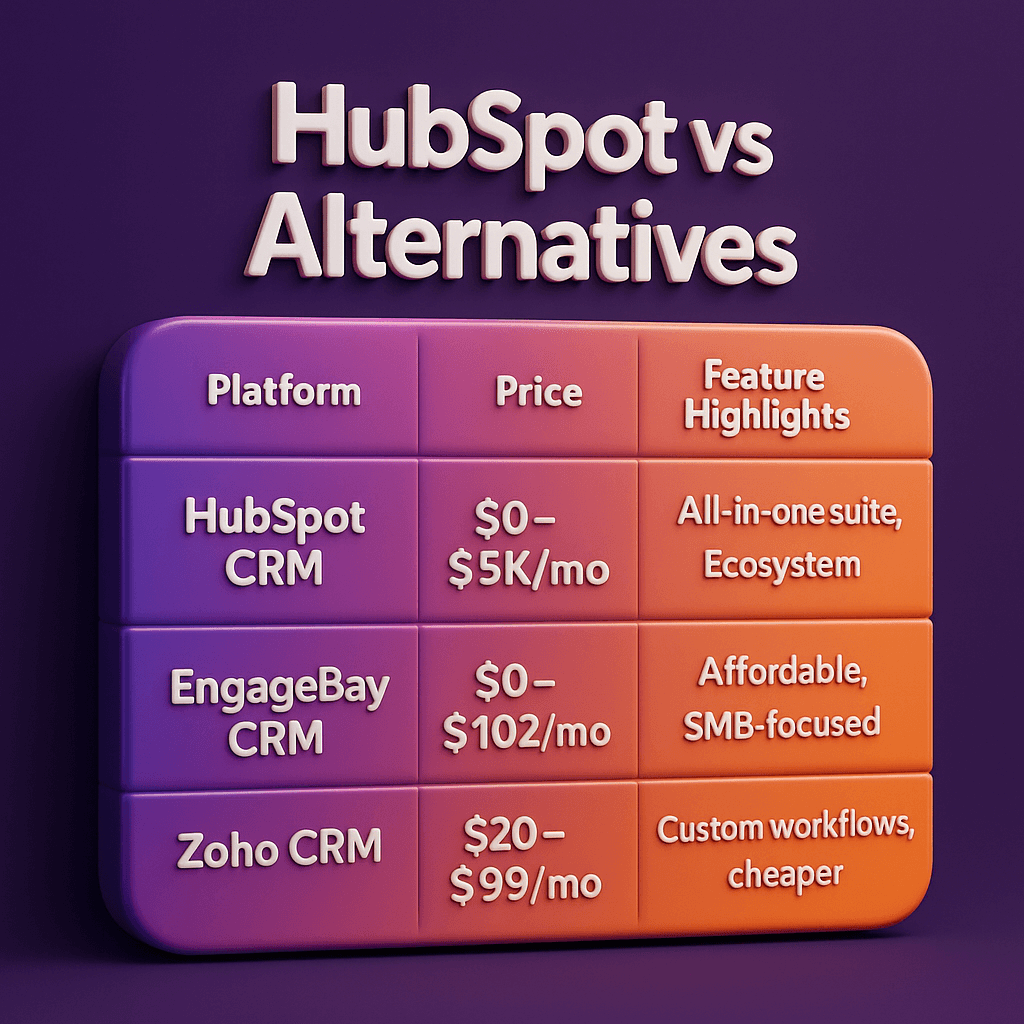
Now let’s get to the details.
Table of Contents
What Is HubSpot CRM and Why It Matters
HubSpot is a cloud-based CRM that rolls marketing, sales, service, content‑management, and operations tools into a single workspace. Instead of toggling between disparate apps, teams get a unified dashboard for capturing and nurturing leads, automating follow‑ups, tracking deals, and publishing inbound content—all under one roof.
Why does that matter? Because centralization fuels better data visibility and faster revenue cycles. With customer emails, chat transcripts, deal stages, and analytics living in one ecosystem, reps can deliver timelier, more personalized outreach. Marketers, meanwhile, can build end‑to‑end campaigns—from blog post to closed‑won—without exporting lists or stitching reports together. The result is higher productivity, smoother hand‑offs, and a clearer picture of ROI at every touchpoint.
That said, while the free version lets you test up to 23 core features, many advanced functions—like custom reporting, sophisticated automation, and premium support—sit behind steeper paid tiers. So before committing, SMBs should weigh HubSpot’s comprehensive toolkit against their budget and growth roadmap. Still, when businesses ask “What is HubSpot”, the short answer is: a powerhouse CRM that unifies your customer journey and scales your inbound strategy—provided the price fits your plan.
Is HubSpot CRM Free to Use?
Uhmmm…this question is a tough nut to crack. And a single-word answer wouldn’t do it justice. Let’s walk through HubSpot’s free plans to help you get the full picture.
HubSpot’s free CRM software allows you to use up to 23 free features such as ad management, email marketing, list segmentation, contact management, ticketing, deal pipeline, and app marketplace integrations.
The functionality of HubSpot can be further extended through its rich ecosystem of HubSpot-certified apps, such as SuperJoin (a HubSpot and Google Sheets integration app), which further enhances its capabilities.
On its standalone solutions such as the HubSpot all‑in‑one marketing hub, you also have access to any of these free features relevant to each hub.
But that’s where the good news ends.
While these features are free, they have considerable limitations. An example is HubSpot’s built-in reporting—a critical tool for every business. On the free plan, you only have access to basic analytics. With insufficient data, optimizing your processes and scaling your business becomes an uphill battle.
So even though you might start out free, you need to upgrade to a paid plan for better functionality of these essential features.
Read also: Is HubSpot CRM Truly Free? An Unbiased Guide (with User Reviews)
HubSpot Paid Plans
Currently, there are two categories in HubSpot’s paid plans; the all-in-one CRM suite and the single hubs.
The all-in-one CRM suite combines all the tools in single hubs into one software. Moving from free tools to HubSpot’s best CRM suite plan could cost you up to $5,000 every month and $60,000 when billed yearly.
$60,000 a year is not a chicken change for SMBs. That’s a fortune.
How about you opt for a single hub? Well, you’ll pay a lower but still substantial amount.
A hub is a system within a CRM suite that caters to specific processes. These systems can function independently of others. For example, EngageBay’s Marketing Bay, CRM & Sales Bay, and Service Bay are equivalents of hubs.
There are 5 hubs within HubSpot’s CRM suite. Let’s briefly look at each one, its pricing plan, and its functionalities.
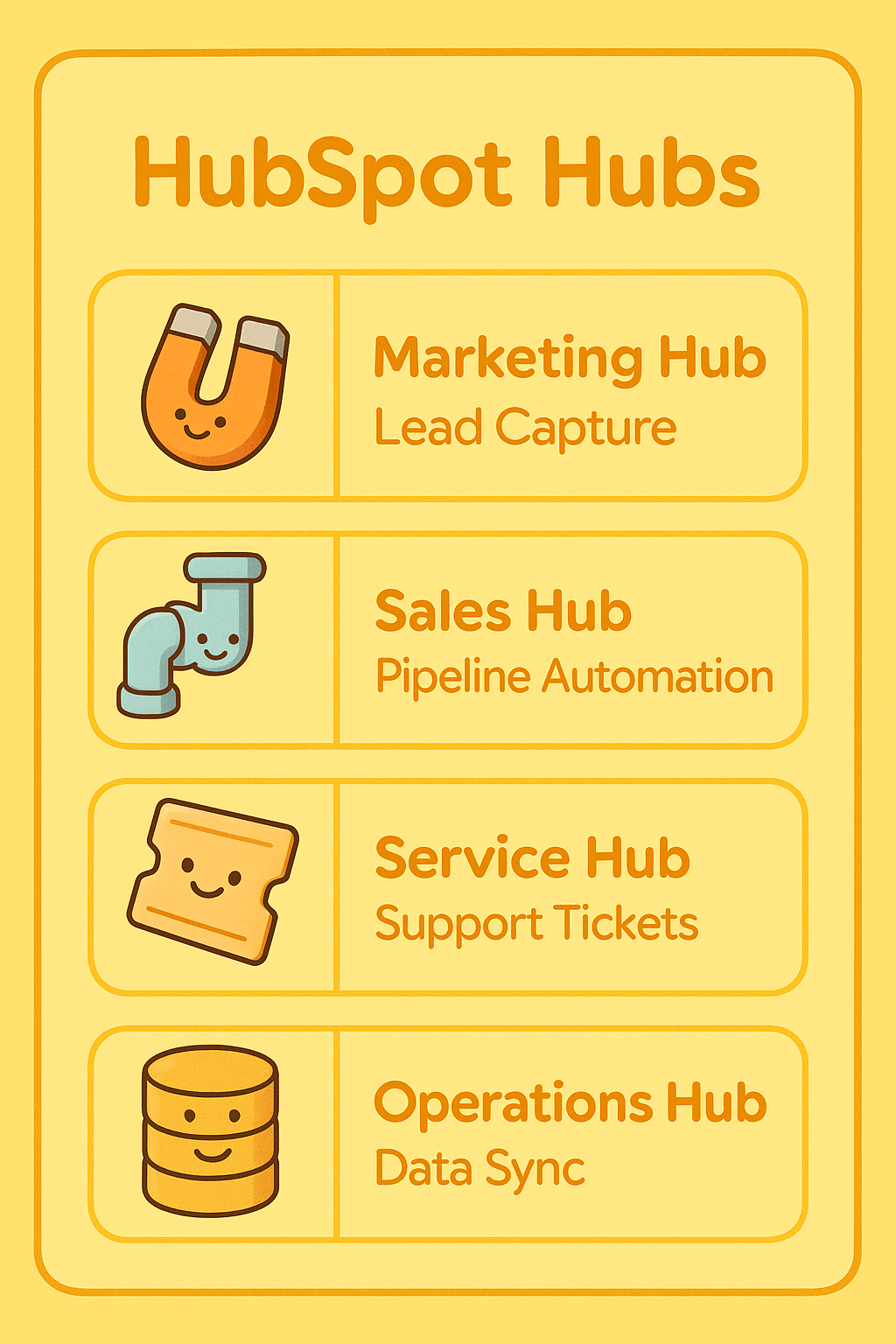
HubSpot Marketing Hub
The HubSpot all‑in‑one marketing software provides marketing tools businesses need to attract visitors, convert leads, and generate reports.
Notable features in HubSpot’s marketing hub include tools for content creation, SEO, ads management, social media management, landing page builder, marketing automation, multi-touch revenue attribution, and reporting & analytics.
HubSpot Marketing Hub Pricing
- HubSpot Marketing Hub Starter: Comes with 1000 marketing contacts and increased functionality of free features for $50/month.
- HubSpot Marketing Hub Professional: Designed for up to 10 teams, gives you access to 2,000 marketing contacts, everything in the starter pack, and additional features. Pricing starts from $890/monthly plus a one-time onboarding fee of $3,000.
- HubSpot Marketing Hub Enterprise: Supports 300 teams, 10,000 marketing contacts, more scalability in what’s available on the pro pack, and other features. It costs $3,200/month paid yearly and a $6,000 one-time onboarding fee.
HubSpot Sales Hub
The sales hub allows sales teams to track leads and prospects, optimize sales processes, and close more deals. Popular features include email templates & tracking, conversation intelligence, live chat, pipeline management tool, sales automation, sales analytics & reporting dashboards.
HubSpot Sales Hub Pricing
- Starter: Includes 2 paid users, fewer limitations of the free features, and additional features for $50/month upwards.
- Pro: Pricing starts from $500/month for the starter pack tools plus 5 paid users, automation, advanced reporting & analytics, personalization tools, technical support, and price & quote configuration. Currently, the required one-time onboarding fee is $375.
- Enterprise: The enterprise plan allows for everything in the pro plan, 10 paid users, extensive customization, advanced permissions, and more features for $1,200/month paid yearly. You’ll also pay a one-time $3,000 onboarding fee.
HubSpot Customer Service Hub
HubSpot’s customer service hub contains tools for communicating with customers and delivering great customer service. Features here include omnichannel messaging, live chat & conversational bots, automation, knowledge base, and canned snippets.
HubSpot Service Hub Pricing
- Starter: For $50/month, you’ll get more features within the free tools plus bots, calling features, shared inbox, email templates, basic ticket automation, and other simple features.
- Pro: You have access to the starter tools, help desk automation, knowledge base, customer experience/service analytics, customer portal, and more. Currently, pricing starts from $400 but will soon increase to $500, according to HubSpot. The one-time onboarding fee is $375.
- Enterprise: The ultimate sales plan comes with more access to what’s available on the pro and other advanced features the HubSpot platform offers. Pricing starts at $1,200/month paid yearly with an additional one-time onboarding fee of $3,000.

HubSpot CMS Hub
In the CMS hub, you can access content marketing tools for building a website and creating blog posts. This includes a website hosting tool, drag-and-drop editor, security features, SEO recommendations, contact attribution reporting, and payment support.
HubSpot CMS Hub Pricing
- Starter: Pricing starts at $25 for premium hosting, content delivery network, website security, basic website building tools, live chat, & forms, and reporting.
- Professional: You get everything in the starter plan, default user & team permissions, dynamic personalization, Google Search Console integration, and additional features for $400/monthly.
- Enterprise: Besides the pro tools, you can access advanced features like single sign-on, site performance monitoring, adaptive testing, and web apps. Pricing starts at $1,200/month paid yearly.
HubSpot Operations Hub
Tools within HubSpot’s latest operations hub help businesses automate their processes and connect data and apps into one place. Tools in this hub include data sync, data quality automation, workflow extensions, custom process automation, and custom report builder.
HubSpot Operations Hub Pricing
- Starter: This plan offers the free CRM plus customer data sync, reporting dashboard, list segmentation, multiple currencies, and email/in-app support for $50/month.
- Pro: You’ll get everything in the starter plan plus additional features like programmable automation, record customization, standard customer scoring, and webhooks for $800/month.
- Enterprise: Finally, the most expensive plan in this hub gives you access to the pro tools and advanced customization and data management features for $2,000/month paid yearly.
Read also: HubSpot vs MailChimp — A Complete Product Comparison
HubSpot 2024 Pricing Update
Based on the above information, you might already have guessed that HubSpot is quite expensive.
How would you feel if I told you HubSpot’s new pricing changes indirectly makes the software even more expensive?
Let’s get started.
In March 2024, HubSpot introduced two new seat-based pricing model for all new users (existing users will be moved to the new structure during renewals). Here’s a quick summary of the model:
- The two new seats: Core seats and View-Only seats.
- The View-Only seat does not offer any edit access. All plans offer unlimited free View-Only seats. The Core Seat offers users edit access to all the features in their subscriptions.
- The free edit-access seats that HubSpot was offering previously no longer exist – they are now the paid ‘Core Seats’. This means that those who enjoyed having free edit access previously should now purchase at least a Core seat to continue editing (or do away with a View-Only seat).
- The Sales & Service seat offers core seat capabilities as well as extra features for sales and service.
This table can help you understand the new pricing updates further:
| User requirement | Previous pricing structure | New pricing structure |
| Users requiring view-only access to reports, records, and other data | Included in the free plan | Now offered in the free, View-Only seat |
| Users requiring edit access to records and reports, email tracking, and other editable tasks | Included in the free plan | Now offered in the paid, Core seat |
| Users requiring sales and service-specific features | Dedicated Sales and Service seat | Dedicated Sales and Service seat |
HubSpot Pricing Decoded (2025): What They Don’t Want You to Know
Why Is HubSpot CRM So Expensive for SMBs?
First off, HubSpot’s suite of tools can serve organizations with up to 300 teams. This makes it ideal for larger businesses. That said, it’s no surprise that their pricing plan reflects this targeting, even if you’re on their lowest-paid package.
Besides the plans, add-ons follow the same route and can quickly result in huge bills. Say you’re using the starter package, which costs $50, and you decide to get a little functionality boost. The only API limit increase available for this level costs $500. That’s 10x higher than the initial plan.
Let that sink in for a second.
Of course, large companies with higher needs and bigger budgets can afford these astronomical fees and justify their use. But for startups and small businesses with limited resources, using the HubSpot CRM platform requires lots of thought because of the hefty price tags. This results in the big question …
Read also: HubSpot vs SharpSpring — A Side-by-Side Comparison of Key Features
Is HubSpot Worth The Money For Small Businesses?
To understand if HubSpot is a good choice for your small business, there are three main factors to consider:
Your Business Needs
The value of CRM software depends on how well it meets your business needs. Carefully evaluate your immediate and future needs against the features in HubSpot. Does it fit into your processes? Does it support your overall marketing goals and objectives? Is it scalable? Also, what is HubSpot used for?
It’s important to know that while the HubSpot CRM platform has some cool features, critical tools that you’ll need in the future are likely locked away in more expensive plans that cost at least 1,000% more than their starter plans.
Here’s what a customer says about this:
This was two years ago. Today, the outlook is still the same.
Read also: 9 CRM Best Practices for Small to Large-scale Businesses
Your CRM Budget
How much do you want to invest in a CRM? Your budget goes beyond the monthly/yearly cost of the software. You need to factor in implementation costs, future upgrades, add-ons, and integrations.
For a clearer view of what HubSpot might cost you, imagine you want to create sequences. To do this, you’ll have to choose the PRO VERSION within the CRM suite.
A simple breakdown:
- Depending on the discount offered, this plan = $1,600
- Billed annually, we have= $19,200
- Add a combined one-time HubSpot onboarding fee= $3,750
- You’ll have to cough up $22,950
That’s a huge bill that’s out of reach of many small businesses. As such, you’ll have better chances with other tools that offer these HubSpot CRM features for a fraction of the cost.
For example, on EngageBay, you can create a limited number of email sequences for free!
Technical Support
There’s only so much that free help guides and tutorials can cover. To get quality help for your CRM implementation success, you need specialized training and support that aligns with your processes.
Most software like EngageBay that targets small businesses offers extra functionality like email & chat support in the free CRM, free onboarding, and more.
But in the HubSpot CRM platform, you won’t have that support in the free tools. Also, getting implementation guidance is tricky as onboarding fees can get up to $6,000 in most plans.
If, after evaluating these factors, HubSpot isn’t exactly what you’re looking for, below is a powerful alternative worth checking out.
Read also: 9 Challenges of CRM Implementation & How to Dust Them Off
What is a Great HubSpot Alternative for SMBs?
Like HubSpot, EngageBay is an all-in-one CRM platform with tools that can transform your digital marketing, sales, and customer service.
EngageBay Vs HubSpot – Which is Better for CRM?
However, what makes it an excellent choice for SMBs is its affordable pricing, powerful features, flexible plan, and exceptional customer service.
Here’s a closer look at what makes EngageBay a prime choice:
Affordable Pricing Plans
EngageBay pricing plans are a match made in heaven for SMBs.
Source: HubSpot vs EngageBay
You can start at $0 on the free plan and get additional features for as low as $12.74/month (biennially) in the all-in-one CRM basic plan.
As your business grows, you can advance to the growth package from $55.24/month for comparative features in the HubSpot Pro plan.
The highest package, which gives you access to all the features you need plus a dedicated account manager, costs $101.99/month only. You’ll scarcely find any HubSpot alternatives that offers such functionality at this friendly pricing.
EngageBay also offers 10% off on all yearly plans and 20% off on biennial plans.
Rich Functionality
EngageBay has an impressive arsenal of tools for SMBs. From the free CRM tool, you get lots of features like email marketing to 500 contacts, live chat, email sequences, landing pages, 360-degree contact view, lead grabbers, and autoresponders.
The basic plan comes with additional features like SMS marketing, ticketing management, a social suite, web pop-ups, canned responses, and group management. You’ll also get 1000 contacts, 3000 branded emails, and an SSL for your landing pages.
For the Growth package, you’ll have access to A/B testing, marketing automation, push notifications, proposals, call reports, and more.
Finally, the Pro EngageBay plan not only comes with advanced functionality of what exists but adds role management, conversational inbox, role management, web analytics, etc.
These are highlights. To know what tools are available for your business, check out EngageBay’s extensive features for free & paid plans.
Read also: HubSpot vs Keap — Is HubSpot Really a Better Product?
Easy To Use
A common scenario: You buy a CRM, try setting it up, and find out it’s as complex as navigating a spaceship. This leaves you no choice but to waste huge amounts of time setting up simple tasks or spend lots of money on onboarding.
That’s not the case in EngageBay.
Our software is intuitive and super easy to use whether you’re a seasoned marketer or a beginner. In fact, each feature and bay is designed to help you perform tasks in just a few clicks.
You Aren’t Locked Into Annual Contracts
Flexible pricing is the way forward, and we’re here to help. Regardless of which plan you choose, you have access to monthly and yearly plans. There’s no mandatory annual commitment.
You can use EngageBay for as many months as you like and cancel anytime.
Read more: 8 Fantastic HubSpot Alternatives for Small Businesses (Features, Pricing)
Responsive Customer Support Team
Run into a snag? Our customer support team is always available to offer technical support. It doesn’t matter if you’re not using a paid plan. All EngageBay users can get help from our email or chat support to solve from the simplest issues to complex ones.
If you’re looking for highly specialized assistance beyond these options, you can also get a dedicated account manager in the pro plan.
Are you looking to see what EngageBay offers? You can sign up for a free trial; no credit card is required.
What’s more? If you eventually commit to any package after the trial, we offer free onboarding that saves you thousands of dollars.
Marketing Madness: HubSpot vs EngageBay Face‑Off!
Learn more about EngageBay:
Sign up with EngageBay for free
Wrap Up on HubSpot CRM, Features, and Pricing
We believe this post has given you a high-level overview of what to expect from HubSpot CRM. On HubSpot, you have three options: the free tools, the CRM suite, or any of its various hubs.
The free tools come with many limitations that could affect your ability to scale your business. On the other hand, if you choose any of HubSpot’s paid plans, you have to buckle up because high subscription fees will come hitting on your business.
Plus, there are one-time onboarding fees depending on the chosen plan. All of these can quickly balloon up to $22,950 – $72,000 for the pro and enterprise packages.
For a small business owner with a limited budget, this is a steep price.
The best CRM is one that offers you the features you need at a fair cost. And such a software solution is the EngageBay CRM designed specifically for SMBs that want maximum value at affordable pricing.
Looking to see how EngageBay CRM can help you grow your small business? Sign up for free today.
Related reading:
- The best CRM Tools for Small Businesses
- The 14 Best CRM Automation Software in 2024
- 15 Best Marketing Automation Tools for Small Businesses
- Is HubSpot Worth It? In-Depth Review for Small Businesses
A: Yes, HubSpot offers a free‐forever tier with 20‑plus tools (contact management, email marketing, live chat, basic dashboards, etc.). However, advanced reporting, automation workflows, and removal of HubSpot branding are locked behind paid plans—so most growing teams upgrade sooner rather than later.
A: HubSpot’s paid tiers charge per “core seat” and by the size of your contact list, plus one‑time onboarding fees on most Professional and Enterprise packages. Add‑ons (like additional API calls or reporting modules) can quickly multiply the bill, pushing annual costs well past $20K for even mid‑sized teams.
A: The suite bundles five hubs—Marketing, Sales, Service, CMS, and Operations—under one login. Each hub can be bought separately, but the all‑in‑one CRM plan unlocks every tool for campaign automation, content hosting, ticketing, analytics, and data sync in a single dashboard.
A: The free tier caps you at 1,000 marketing contacts, limits dashboards to basic metrics, imposes HubSpot branding on forms and emails, offers no workflow automation, and restricts support to community forums. Those constraints can hamper scaling efforts once your pipeline or email volume grows.
A: EngageBay provides comparable all‑in‑one marketing, sales, and service tools but starts at $0 (free plan) and scales to just $101.99 per user on its top Pro tier—without onboarding fees or seat‑based surcharges—making it budget‑friendly for startups and SMBs.
